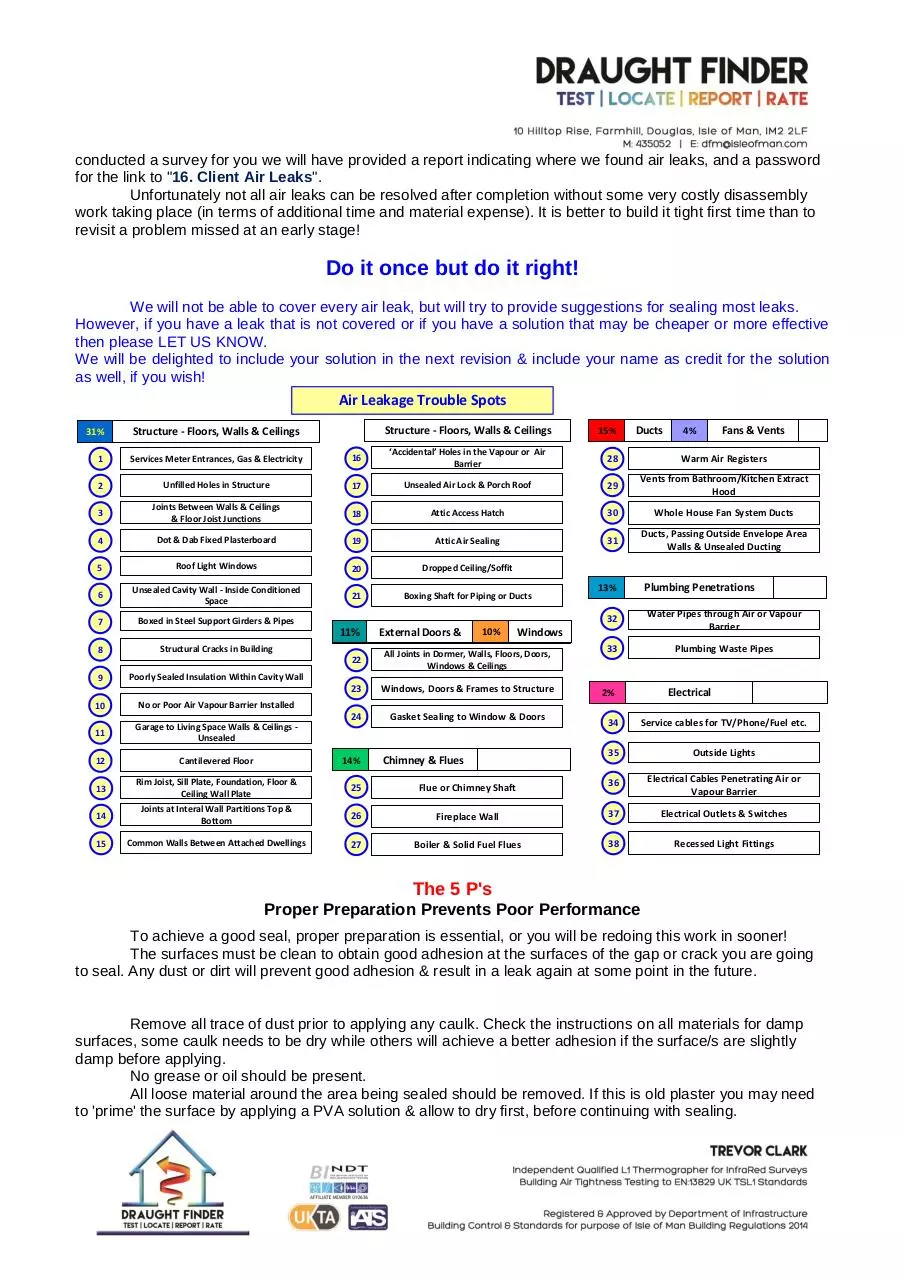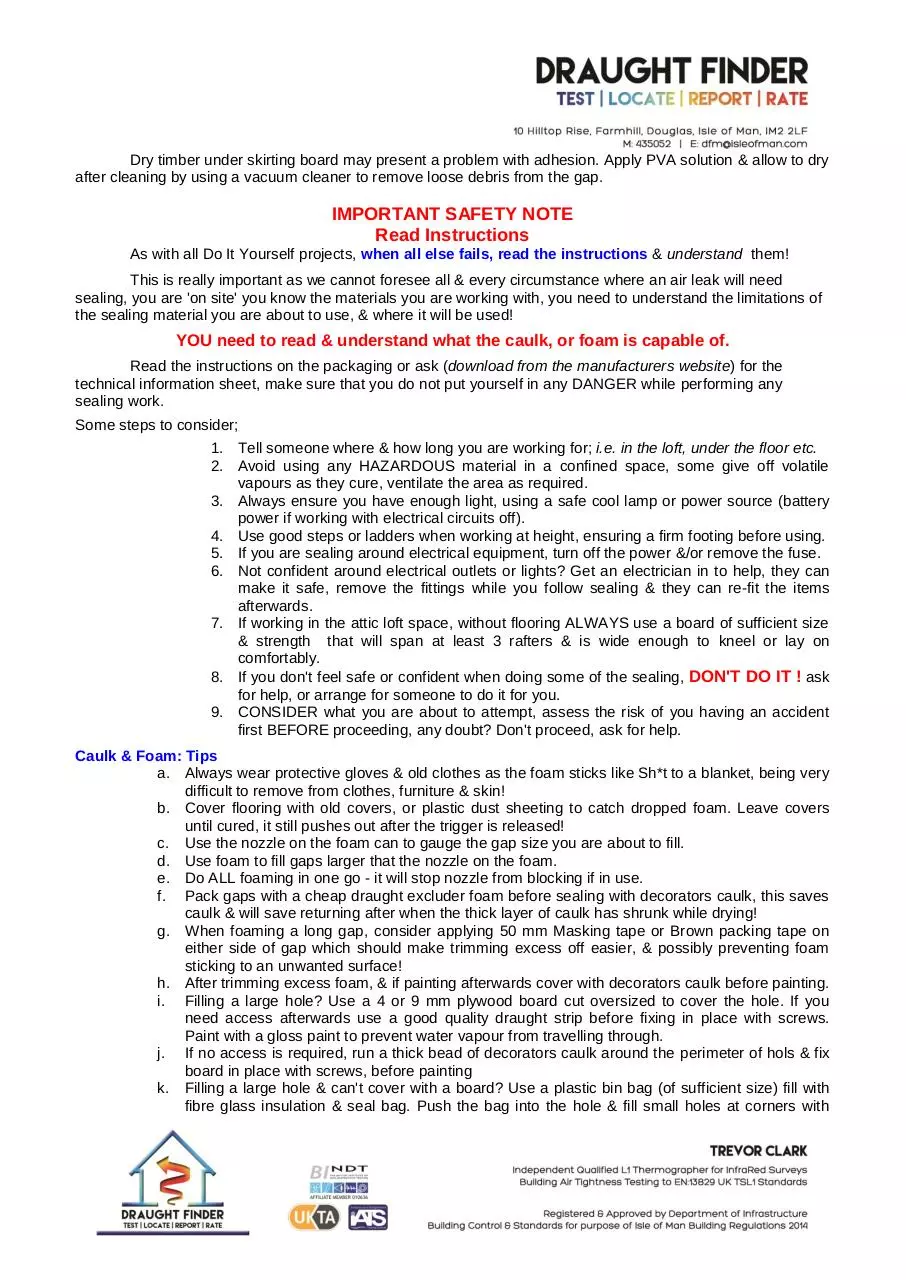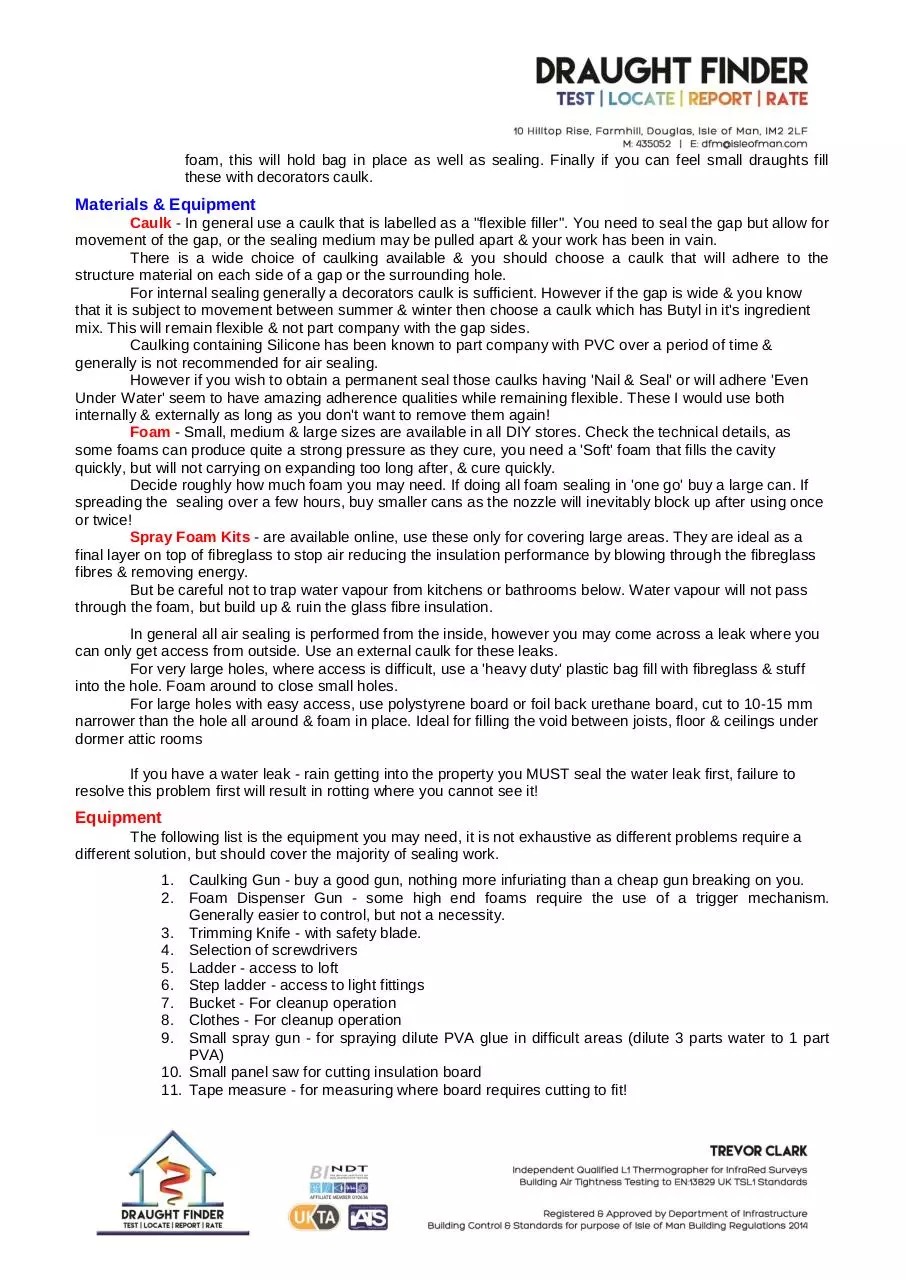16. Client Air Sealing Tips 05.09.2015 (PDF)
File information
Author: Andrew R.J. Dudgeon
This PDF 1.5 document has been generated by Microsoft® Office Word 2007, and has been sent on pdf-archive.com on 09/10/2015 at 14:19, from IP address 46.31.x.x.
The current document download page has been viewed 385 times.
File size: 1.09 MB (28 pages).
Privacy: public file





File preview
Client Air Sealing Hints & Tips
Existing Property
After Air Tightness Test
to Seal Air Leaks
Building or Refurbishing a new or old property with traditional cavity wall construction or with timber
frame to achieve an air tight building can be daunting, but when you get your head around it, there are simple
ways of achieving an air tight building. As long as you pay a little more attention to the small detailed
amendments required and THINK AIR TIGHTNESS at each stage.
First Test the building to see How Leaky is currently is.
Before air sealing your building our advise would be to have an Air Tightness Test performed - after all
you will not know how effective your sealing work has been unless you know the baseline figure?
See our link to "14. All About Air Tightness - 04.09.2015" for more information.
Where can we find air leaks?
Use the report from your recent Air Tight Survey where Draught Finder will have located your air leaks.
From the photographs in the report locate the area indicated and check where the air leak is on the thermogram
image. If difficult it should have an arrow pointing to the area on the visible photo.
Check which option you are going to use to seal the air leak and proceed with the sealing operation/s
The less air we loose from our buildings, the less our heating bill will be.
Ventilation is IMPORTANT
A word of caution is due at this point, while we are attempting to ensure we build an air tight property,
we should realise that certain parts of the building NEED to have air circulation to remain in good condition for
the life of the building!
"Everything NEEDS to Breathe"
Air MUST be allowed to circulate around the following parts of the building;
1. The underside of any timber on the ground floor.
2. Through the cavity wall.
3. The unheated attic space.
If air is not allowed to circulate around these parts of the structure water will gather and overtime lead to
conditions most suitable for rotting, which in turn will lead to major structural problems and a great deal of
expense to rectify it!
Ventilation of the Building
See our link for "21. Ventilation Information - 05.08.2015" for the low down on ventilation systems.
If after sealing your building, you notice condensation where before there previously was none then you
have probably "over sealed" the building! having an Air Tightness Test before sealing will provide a guide to
how much sealing you need to perform.
If you start suffering from condensation problems the only cure is to introduce ventilation into the
affected room, or consider other ventilation options for the house.
Common Air Leakage Locations and Solutions
The information following pages shown various known Uncontrolled Air Leaks in buildings. In a new
house most of these should have been resolved by the designer before building took place. If we have
conducted a survey for you we will have provided a report indicating where we found air leaks, and a password
for the link to "16. Client Air Leaks".
Unfortunately not all air leaks can be resolved after completion without some very costly disassembly
work taking place (in terms of additional time and material expense). It is better to build it tight first time than to
revisit a problem missed at an early stage!
Do it once but do it right!
We will not be able to cover every air leak, but will try to provide suggestions for sealing most leaks.
However, if you have a leak that is not covered or if you have a solution that may be cheaper or more effective
then please LET US KNOW.
We will be delighted to include your solution in the next revision & include your name as credit for the solution
as well, if you wish!
Air Leakage Trouble Spots
Structure - Floors, Walls & Ceilings
Structure - Floors, Walls & Ceilings
1
Services Meter Entrances, Gas & Electricity
16
‘Accidental’ Holes in the Vapour or Air
Barrier
28
Warm Air Registers
2
Unfilled Holes in Structure
17
Unsealed Air Lock & Porch Roof
29
Vents from Bathroom/Kitchen Extract
Hood
3
Joints Between Walls & Ceilings
& Floor Joist Junctions
18
Attic Access Hatch
30
Whole House Fan System Ducts
4
Dot & Dab Fixed Plasterboard
19
Attic Air Sealing
31
Ducts, Passing Outside Envelope Area
Walls & Unsealed Ducting
5
Roof Light Windows
20
Dropped Ceiling/Soffit
6
Unsealed Cavity Wall - Inside Conditioned
Space
21
Boxing Shaft for Piping or Ducts
7
Boxed in Steel Support Girders & Pipes
8
Structural Cracks in Building
31%
11%
External Doors &
10%
All Joints in Dormer, Walls, Floors, Doors,
Windows & Ceilings
23
Windows, Doors & Frames to Structure
24
Gasket Sealing to Window & Doors
Poorly Sealed Insulation Within Cavity Wall
10
No or Poor Air Vapour Barrier Installed
11
Garage to Living Space Walls & Ceilings Unsealed
12
Cantilevered Floor
13
Rim Joist, Sill Plate, Foundation, Floor &
Ceiling Wall Plate
25
14
Joints at Interal Wall Partitions Top &
Bottom
15
Common Walls Between Attached Dwellings
Ducts
13%
4%
Fans & Vents
Plumbing Penetrations
32
Water Pipes through Air or Vapour
Barrier
33
Plumbing Waste Pipes
Windows
22
9
15%
2%
Electrical
34
Service cables for TV/Phone/Fuel etc.
35
Outside Lights
Flue or Chimney Shaft
36
Electrical Cables Penetrating Air or
Vapour Barrier
26
Fireplace Wall
37
Electrical Outlets & Switches
27
Boiler & Solid Fuel Flues
38
Recessed Light Fittings
14%
Chimney & Flues
The 5 P's
Proper Preparation Prevents Poor Performance
To achieve a good seal, proper preparation is essential, or you will be redoing this work in sooner!
The surfaces must be clean to obtain good adhesion at the surfaces of the gap or crack you are going
to seal. Any dust or dirt will prevent good adhesion & result in a leak again at some point in the future.
Remove all trace of dust prior to applying any caulk. Check the instructions on all materials for damp
surfaces, some caulk needs to be dry while others will achieve a better adhesion if the surface/s are slightly
damp before applying.
No grease or oil should be present.
All loose material around the area being sealed should be removed. If this is old plaster you may need
to 'prime' the surface by applying a PVA solution & allow to dry first, before continuing with sealing.
Dry timber under skirting board may present a problem with adhesion. Apply PVA solution & allow to dry
after cleaning by using a vacuum cleaner to remove loose debris from the gap.
IMPORTANT SAFETY NOTE
Read Instructions
As with all Do It Yourself projects, when all else fails, read the instructions & understand them!
This is really important as we cannot foresee all & every circumstance where an air leak will need
sealing, you are 'on site' you know the materials you are working with, you need to understand the limitations of
the sealing material you are about to use, & where it will be used!
YOU need to read & understand what the caulk, or foam is capable of.
Read the instructions on the packaging or ask (download from the manufacturers website) for the
technical information sheet, make sure that you do not put yourself in any DANGER while performing any
sealing work.
Some steps to consider;
1. Tell someone where & how long you are working for; i.e. in the loft, under the floor etc.
2. Avoid using any HAZARDOUS material in a confined space, some give off volatile
vapours as they cure, ventilate the area as required.
3. Always ensure you have enough light, using a safe cool lamp or power source (battery
power if working with electrical circuits off).
4. Use good steps or ladders when working at height, ensuring a firm footing before using.
5. If you are sealing around electrical equipment, turn off the power &/or remove the fuse.
6. Not confident around electrical outlets or lights? Get an electrician in to help, they can
make it safe, remove the fittings while you follow sealing & they can re-fit the items
afterwards.
7. If working in the attic loft space, without flooring ALWAYS use a board of sufficient size
& strength that will span at least 3 rafters & is wide enough to kneel or lay on
comfortably.
8. If you don't feel safe or confident when doing some of the sealing, DON'T DO IT ! ask
for help, or arrange for someone to do it for you.
9. CONSIDER what you are about to attempt, assess the risk of you having an accident
first BEFORE proceeding, any doubt? Don't proceed, ask for help.
Caulk & Foam: Tips
a. Always wear protective gloves & old clothes as the foam sticks like Sh*t to a blanket, being very
difficult to remove from clothes, furniture & skin!
b. Cover flooring with old covers, or plastic dust sheeting to catch dropped foam. Leave covers
until cured, it still pushes out after the trigger is released!
c. Use the nozzle on the foam can to gauge the gap size you are about to fill.
d. Use foam to fill gaps larger that the nozzle on the foam.
e. Do ALL foaming in one go - it will stop nozzle from blocking if in use.
f. Pack gaps with a cheap draught excluder foam before sealing with decorators caulk, this saves
caulk & will save returning after when the thick layer of caulk has shrunk while drying!
g. When foaming a long gap, consider applying 50 mm Masking tape or Brown packing tape on
either side of gap which should make trimming excess off easier, & possibly preventing foam
sticking to an unwanted surface!
h. After trimming excess foam, & if painting afterwards cover with decorators caulk before painting.
i. Filling a large hole? Use a 4 or 9 mm plywood board cut oversized to cover the hole. If you
need access afterwards use a good quality draught strip before fixing in place with screws.
Paint with a gloss paint to prevent water vapour from travelling through.
j. If no access is required, run a thick bead of decorators caulk around the perimeter of hols & fix
board in place with screws, before painting
k. Filling a large hole & can't cover with a board? Use a plastic bin bag (of sufficient size) fill with
fibre glass insulation & seal bag. Push the bag into the hole & fill small holes at corners with
foam, this will hold bag in place as well as sealing. Finally if you can feel small draughts fill
these with decorators caulk.
Materials & Equipment
Caulk - In general use a caulk that is labelled as a "flexible filler". You need to seal the gap but allow for
movement of the gap, or the sealing medium may be pulled apart & your work has been in vain.
There is a wide choice of caulking available & you should choose a caulk that will adhere to the
structure material on each side of a gap or the surrounding hole.
For internal sealing generally a decorators caulk is sufficient. However if the gap is wide & you know
that it is subject to movement between summer & winter then choose a caulk which has Butyl in it's ingredient
mix. This will remain flexible & not part company with the gap sides.
Caulking containing Silicone has been known to part company with PVC over a period of time &
generally is not recommended for air sealing.
However if you wish to obtain a permanent seal those caulks having 'Nail & Seal' or will adhere 'Even
Under Water' seem to have amazing adherence qualities while remaining flexible. These I would use both
internally & externally as long as you don't want to remove them again!
Foam - Small, medium & large sizes are available in all DIY stores. Check the technical details, as
some foams can produce quite a strong pressure as they cure, you need a 'Soft' foam that fills the cavity
quickly, but will not carrying on expanding too long after, & cure quickly.
Decide roughly how much foam you may need. If doing all foam sealing in 'one go' buy a large can. If
spreading the sealing over a few hours, buy smaller cans as the nozzle will inevitably block up after using once
or twice!
Spray Foam Kits - are available online, use these only for covering large areas. They are ideal as a
final layer on top of fibreglass to stop air reducing the insulation performance by blowing through the fibreglass
fibres & removing energy.
But be careful not to trap water vapour from kitchens or bathrooms below. Water vapour will not pass
through the foam, but build up & ruin the glass fibre insulation.
In general all air sealing is performed from the inside, however you may come across a leak where you
can only get access from outside. Use an external caulk for these leaks.
For very large holes, where access is difficult, use a 'heavy duty' plastic bag fill with fibreglass & stuff
into the hole. Foam around to close small holes.
For large holes with easy access, use polystyrene board or foil back urethane board, cut to 10-15 mm
narrower than the hole all around & foam in place. Ideal for filling the void between joists, floor & ceilings under
dormer attic rooms
If you have a water leak - rain getting into the property you MUST seal the water leak first, failure to
resolve this problem first will result in rotting where you cannot see it!
Equipment
The following list is the equipment you may need, it is not exhaustive as different problems require a
different solution, but should cover the majority of sealing work.
1. Caulking Gun - buy a good gun, nothing more infuriating than a cheap gun breaking on you.
2. Foam Dispenser Gun - some high end foams require the use of a trigger mechanism.
Generally easier to control, but not a necessity.
3. Trimming Knife - with safety blade.
4. Selection of screwdrivers
5. Ladder - access to loft
6. Step ladder - access to light fittings
7. Bucket - For cleanup operation
8. Clothes - For cleanup operation
9. Small spray gun - for spraying dilute PVA glue in difficult areas (dilute 3 parts water to 1 part
PVA)
10. Small panel saw for cutting insulation board
11. Tape measure - for measuring where board requires cutting to fit!
Client Air Leak Sealing Tips
After reading the above information as a client you will have been provided with a password for further
Hints & Tips on air sealing. Visit our website www.draught-finder.co.uk Page 4 "16. Client Air Sealing Tips"
In this document we try to cover the common areas where we have found air leaks in new & existing
properties. Some solutions will be duplicated, we have tried to group these together.
Some of the leakage trouble spots should have been sealed during the building construction stage, as
such these have been omitted as the sealing afterwards can be difficult to explain briefly in this document & in
practice.
This part of the document is an 'on going' Work In Progress - if you come across a leak that is NOT shown,
please let us know. We will suggest a solution & include the problem & solution into the next revision of the
document.
Let us know if you have a better solution for these air leaks.
We have tried to provide options for you to consider prior to starting sealing;
1.
2.
3.
4.
The Best method
A Good method
An Easy method
Quick Fix
E MR C
- Expensive
- Medium to cost
- Reasonable cost
- Cheap cost
- done once
- done once
- may need repeating in 5 to 10 years
- done once
&
will be indicated on the following leaks as a guide cost.
We will use sketch diagrams to show clearly the fault & solution suggestions on some but not all leaks.
1.
Building Structure - Meter Entrance
1. This may be where the electrical mains service cable
enters the property or the cables from the meter pass
through the Envelope from meter box to consumer unit.
2. Also the Gas main feeding the house from behind the
external meter cupboard to the boiler where the pipe
passes through the Envelope.
3. Where Telecom cable enters the house through
Envelope.
4. Where water main enters building (garage?) then into
conditioned space or under kitchen sink.
Sealing After Completion - Existing Building
C - You may need to use foam to fill any large void around the cables and pipes.
Once cured trim away excess foam & spread decorators caulk over exposed foam surface to seal.
Ensure caulk adheres to the surrounding floor or wall to maintain a good seal.
Decorate if required
Look behind the cable, (this area is generally missed!) you may need to spread caulk around the back- use caulk
filler applied with a 'gloved' hand.
Ensure the Air Barrier is sealed around the cable, gas
pipe of telecom cable.
2.
Building Structure - Unfilled Holes
Could be anywhere in the envelope area of the building,
either forgotten or not reported to site supervisor.
Discovered at time of Air Tightness Test.
Sealing After Completion - Existing Building
Should you locate a large hole, either
C - Use an insulation board cut to a slightly smaller size than the hole & foam it in place.
Once cured trim away excess foam & spread decorators caulk over exposed foam.
Ensure caulk adheres to the surrounding floor or wall to maintain a good seal.
Decorate if required
Or
C - Use an insulation board cut to a slightly larger size than the hole.
Use decorators caulk to fix it in place.
Or
C - If the hole has difficult access, use the plastic bag method.
Use enough fibreglass to push into the plastic bag so it will hold itself in the hole & tape or tie to close.
Push the bag into the hole, making sure you have a continuous plastic film facing you.
Any visible gaps should be filled with foam. After curing you may wish to trim & treat as above.
Seal any remaining small gaps with decorators caulk.
3.
Building Structure - Joints at Wall,
Floor & Ceiling Junctions
Every joint where a wall or floor meets the outside
structure has the possibility of leaking. During the
construction & testing procedure these should be found
& appropriate action taken to air seal.
1. Ground Floor
Solid
Stone
Wall
Air leaks in via any gap
Blue Line
Gets through gaps in flooring &
skirting board.
Vent
Ventilation Void
Sealing After Completion - Existing Building
NOTE: If your property has cavity wall construction, consider filling the cavity with urethane foam, [contact
petergray@manx.net for more specialist information] doing this will do two things - insulate the building & close
any air leaks entering dwelling from cavity. Ensure you have resolved any problems with the wall structure first.
Leaks can be found at the following locations;
1. Ground Floor - from under void through floor boards & up around skirting boards. DO NOT stop air entering the
under floor void by blocking up wall vents outside. The timber joist MUST be allowed to breathe.
R - Lift existing floor covering & after locating any required 'pockets' for underfloor access, cover floor with hardboard
or thin plywood sheeting. Sealing each sheet around the edges with caulk while butting joints & sealing with caulk
also. Cutting an oversized hole in the ply for the pocket/s. Use the material cut out to make a cover for the pocket &
seal with thin draught proofing strip, screwing into place for future access.
Fill all gaps around the edge between new floor covering & skirting with foam & or decorators caulk, top & bottom.
See Item 39 for sealing sockets etc
C - If you wish to keep the floor boards visible, you need to fill the gap along each joint, & then seal the gap between
floor & skirting, top & bottom. [Try DraughtEx Floorboard Filler from http://www.draughtex.co.uk ]
Solid
Stone
Wall
GROUND
Air maintains dry
timber in void.
Air stopped by
sheeting on top of
flooring & skirting
board by caulking.
C - Gaps filled with foam
strip
Vent
Ventilation Void
GROUND
2. First (& all floors above)
Air leaks in via unclosed joint
Blue Line
Gets through small gap in
structure & finds a hole via light
fitting &/or flooring above
2. First (& all floors above) - Solid Stone Walls - should be OK, only where holes have been made through the
internal cavity wall is where a draught will probably appear.
Cavity Wall or Timber Frame Construction - Timber joists penetrate the internal cavity, while the joist in a timber
frame dwelling sit on top of the wall structure below. Unless the joints are sealed (unlikely in Cavity construction)
while building was in progress there will be leakage along & around every joist & along the complete wall plate. This
can amount to a significant gap in the whole structure.
It is also very difficult or impossible to obtain an air seal afterwards. See Note at top.
EXISTING
For cavity wall
construction only.
Fill with urethane
foam
BEST PRACTICE
Wall has Air Barrier
installed
Preventing air from
entering Conditioned
space
EXISTING
Without barrier air
can still enter via any
hole in dwelling!
EXISTING
Joints closed &
sealed with filler &
caulk.
Time consuming!
3. Ceiling, Top Plate.
3. Ceiling, Top Plate - All constructions - A timber wall plate, laid on top of the wall & with roof timbers being fixed to
it. Whether rafters or roof trusses the ceiling of the rooms below is also at this level. Any gaps at this point will cause
either an air leak or energy removal from the room below.
While access can be difficult the solution is fairly easy.
Take care when working inside the attic space, especially if the attic does not have a floor. See H&S advice at
beginning.
Air can only ventilate the roof
space
Blue Line
Air leaks in via unclosed joint
Blue Line
Or gets under insulation & finds
a hole via light fitting
Red Line
THERMAL IMPROVEMENT
Simply fixing insulation board
between roof timbers at wall
plate with decorators caulk will
stop air getting under insulation
EXISTING
Joint closed &
sealed with
filler & caulk
BEST PRACTICE
Ceiling has Air Barrier
installed then cross
battened to form service
space for lighting cables.
Preventing air from
entering Conditioned
space
Wall plate sealed, prior to laying insulation.
Roof ventilation above plywood sheathing
Download 16. Client Air Sealing Tips - 05.09.2015
16. Client Air Sealing Tips - 05.09.2015.pdf (PDF, 1.09 MB)
Download PDF
Share this file on social networks
Link to this page
Permanent link
Use the permanent link to the download page to share your document on Facebook, Twitter, LinkedIn, or directly with a contact by e-Mail, Messenger, Whatsapp, Line..
Short link
Use the short link to share your document on Twitter or by text message (SMS)
HTML Code
Copy the following HTML code to share your document on a Website or Blog
QR Code to this page

This file has been shared publicly by a user of PDF Archive.
Document ID: 0000306945.